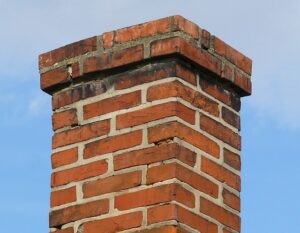
It is important to prevent creosote buildup in your chimney.
The nights are getting cooler, and for many, that means it is finally fireplace season. There is nothing quite like building a beautiful, warm fire in your home’s fireplace and warming up next to it on a cold fall or winter night. Nothing is better, except, possibly, having your fireplace and knowing beyond a doubt that you’re doing it safely since you do all of your yearly maintenance, including chimney cleaning and an annual chimney inspection, and you work to prevent creosote buildup in your chimney. Let’s jump into a quick primer on creosote and how (and why) you should prevent it from building up in your chimney.
What Is Creosote And Why Is It Dangerous?
Burning wood (or fossil fuel) releases creosote because of the distillation of tar in the fuel. If a piece of wood burned completely, there would not be any creosote residue left over, but wood doesn’t burn perfectly, and the wetter it is, the less perfect the consumption rate in terms of energy transfer. When there is moisture, it escapes as steam, carrying tar by product with it. This becomes a sticky and highly flammable material called creosote. Because it is sticky, creosote easily adheres to the chimney’s walls and builds up over time. Because it is flammable, it is the primary cause of chimney fires. Additionally, research is finding that creosote itself is potentially carcinogenic, so you should avoid too much exposure for your own health as well as the health of your chimney.
How Do You Prevent Build-Up?
There are four main things you should be doing to make sure that you’re limiting creosote build up and keeping your home and family safe. First, always use kiln-dried or properly seasoned firewood. Wet firewood (firewood that hasn’t been seasoned) will have a higher moisture content and produce more creosote. Second, open the flue all the way when you have a fire. A partially closed flue produces a less hot fire, and a cooler fire produces more creosote because it doesn’t burn the wood as efficiently. Third, use a good fire-building technique to avoid smothering your fire with wood. Remember that a hot fire will burn the most efficiently and create the least creosote. A smothered fire is a cool (but not in a good way) fire. Fourth, don’t slack on the chimney inspection. Make sure you’re keeping the creosote under control with a yearly inspection.
Call the Experts at Champion Chimneys for a Chimney Inspection Today!
Champion Chimneys, Inc. is a fully licensed, bonded, and insured chimney service company that has served customers in Baltimore County, Howard County, and Anne Arundel County, Maryland, since 2001. Our team is trained and certified by Certified Chimney Professionals, Inc. (CCP, Inc.). Courteous service is our trademark, and our crews arrive on time in uniform, driving fully equipped trucks. We specialize in all aspects of your chimney system. Whether you need chimney and flue cleaning service or a full chimney rebuild or inspection, contact us at 443-Chimney today and let us fix all your chimney problems. Also, follow us on Facebook, Twitter, LinkedIn, and Pinterest.
